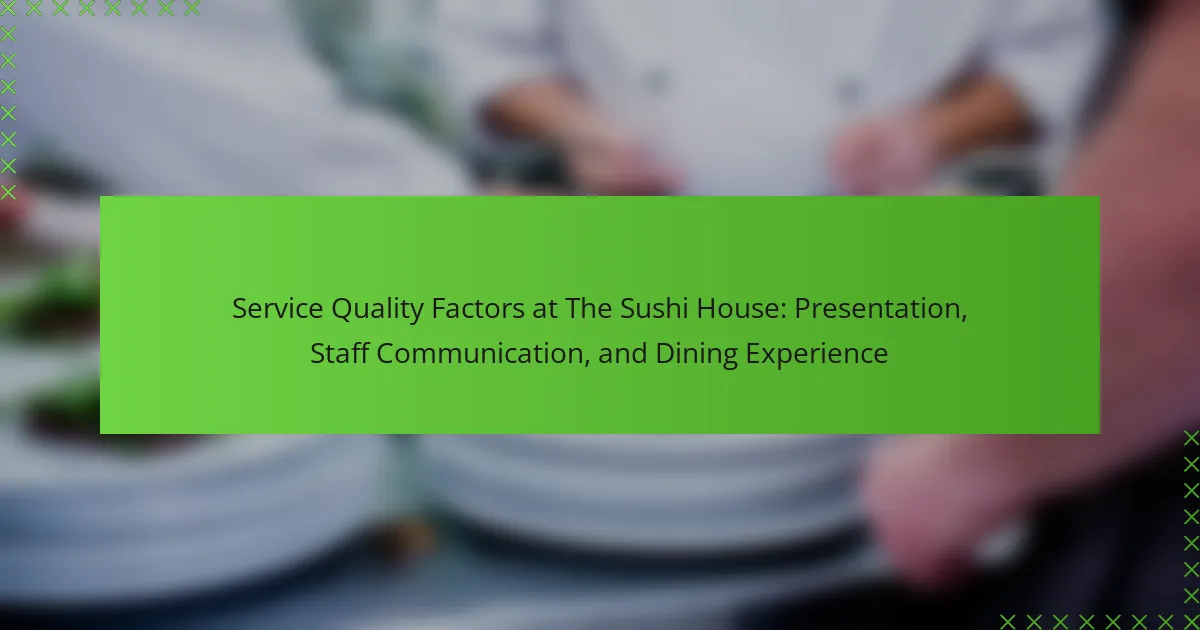
What are the key service quality factors at The Sushi House?
The key service quality factors at The Sushi House include presentation, staff communication, and dining experience. Presentation refers to the visual appeal of the dishes served. High-quality sushi is often artistically arranged, enhancing the overall dining experience. Staff communication involves the attentiveness and responsiveness of the waitstaff. Effective communication can lead to better customer satisfaction and a more enjoyable meal. Dining experience encompasses the ambiance, cleanliness, and overall atmosphere of the restaurant. A pleasant environment contributes significantly to customer perceptions of service quality. These factors collectively influence customer satisfaction and repeat business at The Sushi House.
How does presentation impact the dining experience at The Sushi House?
Presentation significantly impacts the dining experience at The Sushi House. Visually appealing dishes enhance customer satisfaction. The arrangement of sushi can evoke a sense of art and care. This aesthetic quality can lead to increased enjoyment of the meal. Studies show that attractive food presentation can elevate perceived taste. Customers often associate beautiful presentation with higher quality. The Sushi House prioritizes presentation to create memorable dining experiences. This focus can lead to repeat visits and positive word-of-mouth.
What elements contribute to the visual appeal of sushi dishes?
The visual appeal of sushi dishes is primarily influenced by color, arrangement, and garnishing. Color plays a critical role, as vibrant hues from fresh ingredients attract attention. The arrangement of sushi pieces creates an aesthetic balance, enhancing the overall presentation. Additionally, garnishing with herbs or edible flowers adds texture and contrast. The use of high-quality ingredients also contributes to a visually appealing dish, as freshness is visually evident. Finally, traditional serving ware can elevate the presentation, making the dish more inviting. These elements collectively enhance the dining experience by appealing to the senses.
How does plating influence customer perception of quality?
Plating significantly influences customer perception of quality. A well-executed plate enhances visual appeal, which can elevate the perceived value of the food. Research indicates that people often associate the aesthetics of a dish with its taste and overall quality. For instance, studies show that visually appealing presentations can lead to higher customer satisfaction ratings. Furthermore, plating techniques can communicate attention to detail and professionalism, reinforcing positive perceptions. In the context of The Sushi House, artistic plating can enhance the dining experience and encourage repeat visits.
Why is staff communication essential in the dining experience?
Staff communication is essential in the dining experience because it directly impacts service quality and customer satisfaction. Effective communication among staff ensures that orders are taken accurately and delivered promptly. This minimizes errors that can lead to customer dissatisfaction. Additionally, clear communication helps staff coordinate during busy periods, enhancing overall efficiency. Research shows that restaurants with high staff communication ratings see increased customer loyalty and repeat business. A study by the National Restaurant Association indicates that 70% of diners appreciate attentive service, which is facilitated by good communication. Overall, strong staff communication is a key factor in creating a positive dining atmosphere.
What are the best practices for effective staff communication?
Effective staff communication involves clear, concise, and respectful exchanges among team members. Establishing regular check-ins fosters open dialogue. Utilizing communication tools, such as messaging apps, enhances real-time collaboration. Active listening ensures all voices are heard, promoting inclusivity. Providing constructive feedback helps improve performance and morale. Training staff on communication skills is essential for consistency. Encouraging a culture of transparency builds trust among employees. Recognizing and addressing communication barriers leads to more effective interactions.
How does staff communication affect customer satisfaction?
Staff communication significantly impacts customer satisfaction. Effective communication leads to better service delivery. Customers feel valued when staff are attentive and responsive. Clear communication helps address customer needs promptly. It reduces misunderstandings and enhances the dining experience. Research shows that 70% of customers rate staff communication as a key factor in their satisfaction. Positive interactions foster loyalty and repeat business. In contrast, poor communication can lead to dissatisfaction and negative reviews. Overall, strong staff communication is essential for high customer satisfaction.
What aspects define the overall dining experience at The Sushi House?
The overall dining experience at The Sushi House is defined by the quality of food, ambiance, and customer service. The freshness of the sushi is a crucial factor. High-quality ingredients enhance flavor and presentation. The restaurant’s ambiance creates a welcoming atmosphere. Soft lighting and decor contribute to a pleasant dining environment. Staff communication plays a significant role in customer satisfaction. Attentive and knowledgeable staff enhance the dining experience. Timeliness of service also affects overall satisfaction. Prompt service ensures that guests enjoy their meals without unnecessary delays.
How do ambiance and atmosphere contribute to the dining experience?
Ambiance and atmosphere significantly enhance the dining experience. They set the mood and influence customers’ emotions. A well-designed space can create comfort and relaxation. Factors such as lighting, music, and decor play crucial roles. For instance, dim lighting can foster intimacy, while lively music can energize the environment. Research indicates that pleasant surroundings can increase customer satisfaction. A study by Bitner (1992) found that environment affects consumer behavior and perceptions. Thus, ambiance and atmosphere are essential components of a memorable dining experience.
What role does customer service play in enhancing the dining experience?
Customer service plays a crucial role in enhancing the dining experience. It directly influences customer satisfaction and retention. Positive interactions with staff lead to a welcoming atmosphere. Research shows that 70% of dining decisions are influenced by service quality. Efficient service minimizes wait times, making meals more enjoyable. Personalized attention can create memorable experiences for guests. Staff knowledge about the menu enhances customer trust and confidence. Overall, exceptional customer service fosters loyalty and encourages repeat visits.

How do presentation and staff communication work together?
Presentation and staff communication work together to enhance the overall dining experience. Effective presentation of food engages customers and sets expectations. When staff communicate well about the dishes, they provide context and elevate appreciation. Clear communication about ingredients and preparation fosters trust. It also allows for personalized recommendations, improving customer satisfaction. Studies show that well-informed staff can increase perceived value of the meal. This synergy between visual appeal and communication ultimately leads to a memorable dining experience.
What is the relationship between presentation and staff communication?
Presentation significantly influences staff communication in a dining environment. Effective presentation enhances visual appeal and encourages positive interactions among staff and customers. When dishes are well-presented, staff are more likely to communicate confidently about the menu. Research indicates that customers respond favorably to visually appealing meals, which encourages staff to engage more enthusiastically. This interaction can lead to improved customer satisfaction and repeat business. In summary, strong presentation fosters better staff communication, enhancing the overall dining experience.
How can staff enhance the presentation of dishes through communication?
Staff can enhance the presentation of dishes through effective communication techniques. Clear verbal descriptions of the dish can create anticipation and excitement for diners. Staff can highlight key ingredients and cooking methods to engage customers. Visual cues, such as pointing out garnishes or plating styles, can enhance understanding. Non-verbal communication, like enthusiastic body language, can also convey passion for the dish. Additionally, staff can receive feedback from diners to adjust presentation styles. Studies show that effective communication positively impacts customer satisfaction and dining experience.
What feedback mechanisms exist for improving presentation through staff interaction?
Feedback mechanisms for improving presentation through staff interaction include regular training sessions, peer reviews, and customer feedback collection. Training sessions educate staff on presentation standards and techniques. Peer reviews allow staff to evaluate each other’s presentations, fostering collaborative improvement. Customer feedback can be gathered through comment cards or online surveys, providing insights on presentation effectiveness. Implementing these mechanisms can enhance the overall quality of presentations at The Sushi House. Studies indicate that staff engagement in feedback processes leads to higher service quality and customer satisfaction.

What are the common challenges in delivering high service quality?
Common challenges in delivering high service quality include inconsistent service delivery, lack of staff training, and unclear service standards. Inconsistent service can arise from varying employee performance levels. This leads to customer dissatisfaction. Lack of staff training results in employees being unprepared for customer interactions. Unclear service standards create confusion about expectations for both staff and customers. Additionally, managing customer expectations can be difficult. High service quality requires continuous monitoring and improvement. These challenges can ultimately affect customer loyalty and business reputation.
How can The Sushi House overcome presentation challenges?
The Sushi House can overcome presentation challenges by implementing standardized plating techniques. Consistent plating ensures that each dish meets visual expectations. Training staff on these techniques is essential for maintaining quality. Utilizing high-quality serveware enhances the overall aesthetic of the dishes. Incorporating fresh garnishes can elevate the visual appeal of meals. Regularly updating the menu design can keep the presentation fresh and appealing. Gathering customer feedback on presentation can guide improvements. These strategies can lead to a more visually appealing dining experience, ultimately enhancing customer satisfaction.
What strategies can be implemented to maintain high presentation standards?
To maintain high presentation standards, implement consistent training for staff on presentation techniques. Regularly review and update presentation guidelines to ensure clarity. Utilize visual aids and examples to demonstrate desired presentation styles. Conduct periodic evaluations of food plating and overall presentation by management. Gather feedback from customers regarding their visual experience. Encourage creativity while adhering to established standards. Use quality ingredients that enhance visual appeal. Maintain cleanliness and organization in presentation areas to support high standards.
What are the obstacles to effective staff communication?
Obstacles to effective staff communication include unclear messaging, lack of feedback, and cultural differences. Unclear messaging can lead to misunderstandings about tasks and responsibilities. Lack of feedback prevents staff from knowing if they are meeting expectations. Cultural differences may cause misinterpretations of communication styles. Additionally, physical barriers, such as noise and layout, can hinder verbal exchanges. Time constraints can limit opportunities for meaningful conversations. Finally, technology issues can disrupt communication channels, making it difficult to relay important information. Each of these factors contributes to a breakdown in effective communication among staff.
How can training improve staff communication skills?
Training can significantly improve staff communication skills by providing structured learning and practice opportunities. It equips employees with essential techniques for effective verbal and non-verbal communication. Training programs often include role-playing scenarios that simulate real-life interactions. This allows staff to practice responses and receive constructive feedback.
Additionally, training fosters a better understanding of customer needs and expectations. Studies show that organizations with effective communication training experience higher customer satisfaction rates. For example, a report by the Harvard Business Review indicated that companies investing in communication training saw a 25% increase in employee engagement.
Overall, training enhances clarity, reduces misunderstandings, and promotes a positive service environment.
What practical tips can enhance the overall service quality at The Sushi House?
To enhance the overall service quality at The Sushi House, staff should prioritize effective communication. Clear communication between staff and customers can prevent misunderstandings. Training staff on menu items improves their ability to answer questions. Prompt service is essential; aim to serve customers within 10 minutes of ordering. Maintaining a clean and inviting atmosphere also plays a crucial role. Regularly check tables for cleanliness and replenish supplies as needed. Offering personalized recommendations can enhance the dining experience. Engaging with customers through friendly conversation fosters a welcoming environment. Collecting feedback after meals helps identify areas for improvement. Implementing these tips can lead to higher customer satisfaction and repeat visits.
The main entity of this article is The Sushi House, which focuses on key service quality factors that influence customer satisfaction. The article examines the importance of presentation, staff communication, and the overall dining experience in shaping perceptions of service quality. It highlights how visually appealing dishes enhance customer enjoyment and satisfaction, while effective staff communication is essential for delivering quality service and fostering loyalty. Additionally, the article discusses the impact of ambiance and customer service on the dining experience, as well as strategies to overcome challenges in maintaining high service quality.
